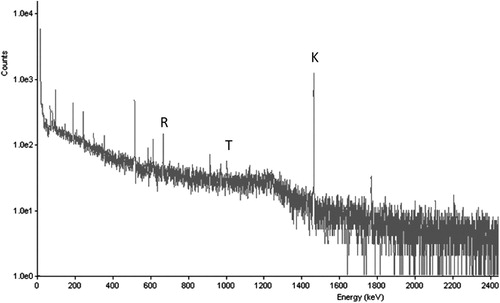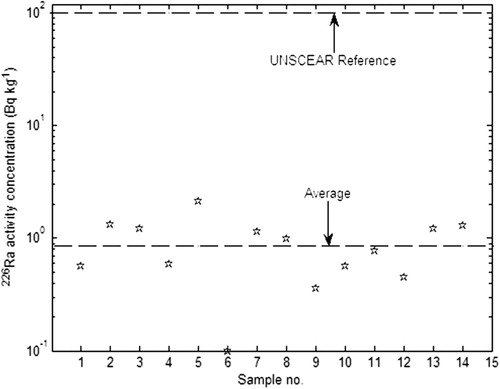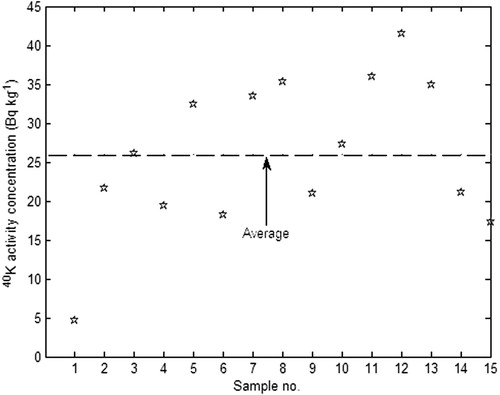Abstract
A study of long-lived gamma emitting radionuclides in canned seafood consumed in Kuwait was performed. The canned seafood samples originated from four different countries. The study targeted the natural radionuclides 232Th, 226Ra, and 40K. The annual effective dose from canned seafood consumption was estimated to be 5 μSv. This value was found to be several orders of magnitude less than the 0.29 mSv year−1 world average of the ingestion exposure from natural sources. Hence, canned seafood consumption in Kuwait is radiologically safe for the presence of the investigated radionuclides.
1 Introduction
Radioactivity in the environment originates mainly from natural sources. Natural radionuclides include isotopes of potassium (40K), uranium (238U and its decay series), and thorium (232Th and its decay series). In addition to being long-lived (in the order of 1010 years), these naturally occurring radioactive materials (NORM) are normally present in environmental samples with varying quantities. Consequently, NORM are typically found in terrestrial and aquatic food chains, with subsequent transfer to humans through ingestion of food. In other words, internal radioactive exposure to the general public is directly related to the amount and type of food consumed. This firm relation raised global interest and concern toward radioactivity exposure from food intake (Al-Masri et al., Citation2004; Chau and Michalec, Citation2009; FSA, Citation2004; Gharbi et al., Citation2010; IAEA, Citation1989; Venturini and Sordi, Citation1999; WHO, Citation2006").
Figure 1 Gamma spectrum for a canned seafood sample, where R, T, and K indicate 226R, 232Th, and 40K, respectively.

A thorough literature search reveals a relatively small number of studies on the radionuclide content of food consumed in Kuwait (Al-Azmi et al., Citation1999; Alrefae, Citation2012"). Such scarcity was the main motive to conduct the current study, in order to meet the important national requirement of establishing a baseline of radioactivity exposure to the general public from food consumption. For a systematic approach, this study focused on one type of food that is widely consumed by various age groups, namely canned seafood. Hence, the aim of this study was to quantify the content of 232Th, 226Ra, and 40K in canned seafood consumed in Kuwait, and to estimate annual effective doses to the general public of various age groups due to this consumption.
2 Materials and methods
Canned fish samples were collected from the Kuwaiti local market. The collection took place between January and June of 2010. To ensure a wide-spread representation, 15 different brands were selected, that covered five different types, crab, salmon, sardine, squid, and tuna ().
Table 1 Brand names of types of samples investigated in this study.
Prior to measurement, each sample was prepared in accordance to standard procedures (IAEA, Citation1989). The preparation included a freeze-drying process that removed the moisture, while preserving essential contents. Such process lasted 4–5 days for each sample. Then, the freeze-dried samples were powdered and placed in cylindrical containers. Dimensions of the containers were 30 mm in radius and 60 mm in height. After being sealed, the sample-filled containers were left for a period of at least 4 weeks to reach a secular equilibrium between parent radionuclides and their daughters. Measurements were performed using a high purity germanium (HPGe) p-type detector. The low background Ortec system, had an energy resolution of 1.75 keV FWHM at the 1.33 MeV 60Co photopeak. This counting system of 80% relative efficiency was connected to a multi-channel analyzer. The detector had a cylindrical geometry with a radius of 37 mm and a height of 88 mm. Energy calibration for the detector was performed using a set of point sources. Efficiency calibration was done using a reference material (IAEA-414) with a cylindrical geometry with the same dimensions as the samples’ containers. Because this reference material is made from fish, it has the same density as the investigated samples. Hence, efficiency values (ε) were calculated using the formula (Knoll, Citation2000).(1) where N is the net counts of the corresponding photopeak after subtracting the background counts. Pγ is the emission probability per disintegration at this specific gamma line. A is the activity concentration of the targeted radionuclide obtained from the reference sheet that came with the reference material. t is the counting time in seconds, and m is the mass of the sample in kg.
To reduce statistical counting error, the samples were counted for a period of 86,400 s (one full day). An empty container was also counted under the same conditions to determine the background counts. For spectrum analysis, Gamma Vision software was used, where the photopeaks considered were 609 keV (226Ra), 911 keV (232Th), and 1460 keV (40K). The activity concentration A (Bq kg−1) of each radionuclide in each sample was calculated from the formula (IAEA, Citation1989).(2)
The minimum detectable activity (MDA) was calculated using the formula (Currie, Citation1968)(3) where Sb is the standard error in the net background count for the photo-peak. The MDA values for the counting system were calculated to be 0.32, 0.29, and 3.67 Bq kg−1 for 226Ra, 232Th, and 40K, respectively.
3 Results
and present the activity concentrations for 226Ra and 40K, respectively, in the canned seafood samples. 226Ra was detected above the MDA in 14 samples with a maximum value of 2.12 ± 0.17 Bq kg−1 (sardine sample) and a minimum value of 0.36 ± 0.07 Bq kg−1 (tuna sample). The average activity concentration was (±SD) 0.97 ± 0.1 Bq kg−1.
As for 40K, it was detected in all samples. The maximum value was 41.56 ± 0.57 Bq kg−1 (tuna sample) and the minimum value was 4.69 ± 0.19 Bq kg−1 (crab sample). The average activity concentration was (±SD) 26.47 ± 0.46 Bq kg−1.
232Th activity concentrations were below the MDA in all samples. Hence, these values were not reported (see ).
4 Discussion
The presence of the natural radionuclides in canned seafood samples was expected. Specifically, detection of 40K in all samples was anticipated due to its natural abundance. As for 226Ra and 232Th, their undetection in samples does not necessarily imply their absence. It is well understood that background levels and system MDA could conceal minor photopeaks (Knoll, Citation2000). In fact, the infrequency of 226Ra and 232Th detection in food samples was reported by various authors (Ababneh et al., Citation2009; Hosseini et al., Citation2006; Jibiri and Okusanya, Citation2008; Yu and Mao, Citation1999").
The results from this study were compared with those reported in the literature. shows the values of the present study agreeing with those reported in the literature. Such agreement is evident by the overlap of the activity concentration values of 40K, as well as the below detection limit values of 232Th.
Table 2 Activity concentrations (Bq kg−1) of 232Th, 226Ra, and 40K in seafood samples in this study, compared with those reported in the literature.
shows the activity concentration of the three targeted radionuclides in different food items that are reported in the literature. 232Th is typically unreported due to its relatively low activity in food. This behavior is seen in the present study. Similarly, 226Ra has relatively low activity in food. Again, this behavior is seen in the presented study. As for 40K, it is clearly present in food items with various concentrations. Such variation in 40K could be related to regional and food-type dependences.
Table 3 Activity concentrations (Bq kg−1) of 232Th, 226Ra, and 40K in various foodstuffs reported in the literature.
The annual effective dose from consumption of canned seafood was calculated using the following formula (UNSCEAR, Citation2000).(4) where D is the annual effective dose (Sv yr−1), A is the activity concentration for the radionuclide (Bq kg−1), E is the dose conversion factor for the radionuclide (Sv Bq−1), and I is the annual intake of canned seafood (kg). Values for E were selected based on the International Commission on Radiological Protection (ICRP) classifications (ICRP, Citation1996) 6.4 and 280 nSv Bq−1 for 40K and 226Ra, respectively. The value of I is taken to be 10.3 kg yr−1 (IAEA, Citation1999). It is noteworthy that this intake value covered all types of seafood, of which canned is one type. Thus, the actual intake value for canned type specifically is less. This study, however, took the conservative approach of using the relatively high intake values. The results of the annual effective dose D showed 3 μSv and 2 μSv from the ingestion of 226Ra and 40K, respectively. Thus the total annual effective dose from ingestion of long lived gamma emitters in canned seafood is 5 μSv, which is of several orders of magnitudes less than 0.29 mSv yr−1 world average of the ingestion exposure from natural sources reported in the literature (UNSCEAR, Citation2000). Therefore, canned seafood consumption in Kuwait is radiologically safe for the presence of the investigated radionulcides. It is important to note, however, that the activity concentration A used in dose calculations was the average for each radionuclide. Hence, the calculated doses are the average annual effective doses. Interestingly, this value of 5 μSv yr−1 is close to its counterpart of 6 μSv yr−1 reported in the literature (Yu et al., Citation1997).
5 Conclusion
Long-lived gamma emitters in canned seafood consumed in Kuwait were investigated. The samples, which were collected from the local market, originated from four different countries. The study targeted three radionuclides, namely 232Th, 226Ra, and 40K. While 40K was detected in all samples, 226Ra was detected in almost all samples, and 232Th was detected in none. In addition, the annual effective dose from the consumption of canned seafood was calculated for the three age groups.
The present study is the first at the national level to investigate the radioactivity of canned seafood. The findings of this study will help in establishing a baseline of radioactivity exposure to the general public from ingestion of foodstuff. However, canned seafood is only one dietary component and the focus of the present study was gamma emitters. To establish a more robust baseline, there is a need to investigate more types of foodstuffs, as well as targeting alpha and beta emitting radionuclides.
Notes
Peer review under responsibility of University of Bahrain.
References
- Z.Q.AbabnehA.M.AlyassinK.M.AljarrahA.M.AbabnehMeasurement of natural and artificial radioactivity in powdered milk consumed in Jordan and estimates of the corresponding annual effective doseRadiat. Prot. Dosimetry1382009278283
- D.Al-AzmiH.R.SaadA.R.FarhanComparative study of desert truffles from Kuwait and other countries in the Middle East for radionuclide concentrationBiol. Trace Elem. Res.71–7219997
- M.S.Al-MasriH.MukallatiA.Al-HamwiH.KhaliliM.HassanH.AssafY.AminA.NashawatiNatural radionuclides in Syrian diet and their daily intakeJ. Radioanal Nucl. Chem.2602004405412
- T.AlrefaeInvestigation of 238U content in bottled water consumed in Kuwait and estimates of annual effective dosesHealth Phys.10220128589
- N.D.ChauB.MichalecNatural radioactivity in bottled natural spring, mineral and therapeutic waters in PolandJ. Radioanal Nucl. Chem.2792009121129
- L.A.CurrieLimits for qualitative detection and quantitative determination; application to radiochemistryAnal. Chem.4019688
- FSAAnalysis of the natural radioactivity content of bottled waters2004The Food Standards AgencyUK, London
- F.GharbiS.BaccoucheW.AbdelliM.SamaaliM.OueslatiA.TrabelsiUranium isotopes in Tunisian bottled mineral watersJ. Environ. Radioact.1012010589590
- T.HosseiniA.A.FathivandH.BaratiM.KarimiAssessment of radionuclides in imported foodstuffs in IranIranian J. Radiat. Res.42006
- IAEA Measurements of radionuclides in food and the environment, technical report series 295 1989IAEAVienna
- IAEA, 1999. Assessment of doses to the public from ingested radionuclides, Safety report series no. 14, Vienna.
- ICRP, 1996. Age-dependent doses to members of the public from intake of radionuclides, ICRP publication 72.
- N.N.JibiriA.A.OkusanyaRadionuclide contents in food products from domestic and imported sources in NigeriaJ. Radiol. Prot.282008405413
- G.F.KnollRadiation detection and measurement2000Wiley
- UNSCEARSources and effects of ionizing radiation2000United Nations Scientific Committee on the Effects of Atomic Radiation United NationsNew York
- L.VenturiniG.A.SordiRadioactivity in and committed effective dose from some Brazilian foodstuffsHealth Phys.761999311313
- WHO, 2006. Guidelines for drinking water quality.
- K.N.YuS.Y.MaoAssessment of radionuclide contents in food in Hong KongHealth Phys.771999686696
- K.N.YuS.Y.MaoE.C.YoungM.J.StokesA study of radioactivities in six types of fish consumed in Hong KongAppl. Radiat. Isot.481997515519


